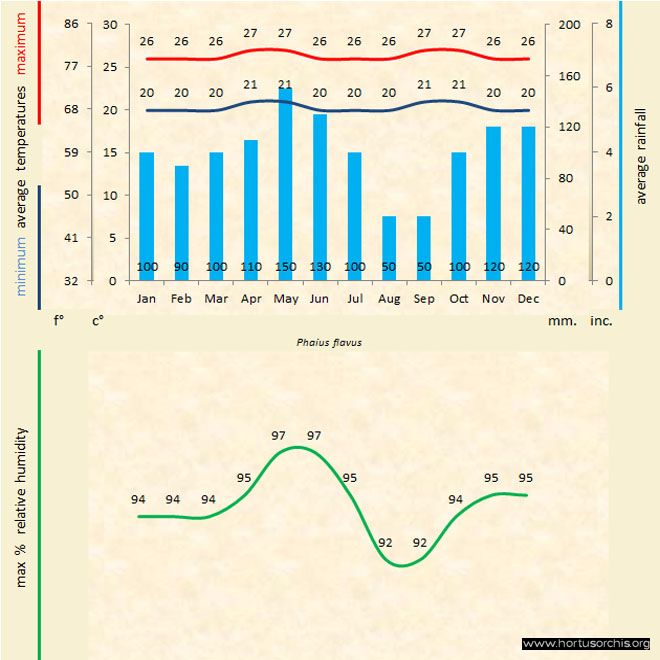
| Phaius flavus photo C. Solimbergo |
| taxonomy | described by | (Blume) Lindley, John |
| published in | The Genera and Species of Orchidaceous Plants 128 1831 | |
| family | Orchidaceae | |
| subfamily | Epidendroideae | |
| tribe | Collabieae | |
| subtribe | Collabiinae | |
| genus | Phaius Louriero 1790 | |
| chromosomes | 2n = 38, 42 | |
| metabolism | CAM pathway, stomata of the leaves are open at night. | |
| (K.Silvera, L.S. Santiago, J.C. Cushman, K. Winter - International Symposium on Plant Biology, August 2013) | ||
| it is useful give the soluble mineal nutriens, on the roots. | ||
| native of | origins | primary and secondary evergreen forest, in India (Assam), Nepal, Sri Lanka, Thailand (Cao Bang, Ha Giang, |
| Hoa Binh, Lai Chau, Lam Dong, Son La, Inthanon Park, Sriracha), China (Fujian, Guangdong, Guangxi, |
||
| Guizhou, Hainan, Hunan, Yunnan, Sichuan), Indonesia, Malaysia, Sulawesi (Gorontalo, Dumoga Bone Park), | ||
| Papua, Taiwan, The Philippines (Luzon), Vanuatu (Aneityum), Japan | ||
| altitude | 120 -1800 m (396 - 5940 ft) | |
| habitat | climate informations from Pinogu (Dunoga Bone National Park, North Sulawesi, Indonesia) | |
| Köppen climate classification : Af, humid tropical climate of the rainforest | ||
| (without a winter season, more and abundant rainfall) | ||
| the weather station data (temperatures are calculated for an altitude of 1000 m / 3300 ft) : | ||
 |
||
| photoperiod | in Pinogu this orchid blooms with a photoperiod, which varies during the year, from 12 h 01 m' to 11 h 59 m' | |
| life form | geophyte on moss - in the wild, no rest | |
| brightness | partial shade to low | |
| inflorescence | length | 40 - 60 cm (16" - 24"), basal |
| nr flowers | 12 - 17, fragrants | |
| size | single flower 4.5 L 7 cm (1.8" L 2.8") - inflorescence 35 L 10 cm (14" L 4") | |
| duration | inflorescence ≈ 45 days | |
| time | to bloom from birth, ≈ 60 days | |
| CITES | appendix | II |

